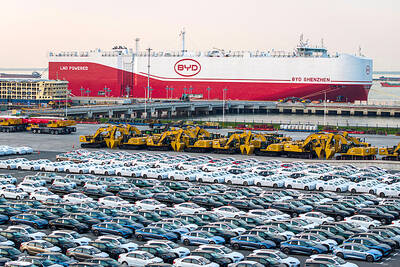Taiwan’s Kaori Heat Treatment Co (高力熱處理工業) has secured a new supply contract with US-based energy systems developer Bloom Energy Inc, which is expected to earn Kaori NT$100 million (US$3 million) in revenue this year.
Under the contract signed on Wednesday in Taipei, Kaori will supply hotboxes — a key component of solid-oxide fuel cells (SOFC) — to Bloom Energy. More than 200 units are expected to be shipped by the end of this year.
Bloom Energy is backed by venture capital firms Kleiner Perkins Caufield & Byers) and New Enterprise Associates. It was identified by Business 2.0 Magazine in 2007 as one of 15 companies that “will change the world.”
Headed by K.R. Sridhar, a former aerospace engineering professor who developed a device for NASA to turn carbon dioxide into oxygen on Mars, Bloom Energy is engaged in the development of solid-oxide fuel cells that allow homes to generate their own electricity.
The fuel cells can convert almost any hydrocarbon fuel into electricity without combustion, and the greenhouse gas production is half of that from conventional energy sources.
Kaori chairman Hans Han (韓顯壽) said the contract with Bloom Energy would give his company access to the renewable energy market, which has received a boost as a result of initiatives by many governments to encourage the development and use of green energy.
Han said Bloom Energy’s products, which will be sold at large retail stores such as Wal-Mart Stores Inc, have a huge global market.
Founded in 1970, Kaori specializes in metal heat treatment processing and the manufacture of metal products.
It is the sole manufacturer of brazed heat exchangers in Taiwan, and has sales in more than 60 countries.
Using technology transferred from Bloom Energy, Kaori launched a new production line for SOFC hotboxes in the second half of this year, Han said.
The two sides signed the supply contract after the shipments passed quality verification, he said.
Green energy is one of five new industries that are being promoted by the government. Under a project approved by the Cabinet in April, the government will invest NT$25 billion over the next five years in the development of renewable energy and will subsidize the general installation of energy-saving devices.
It will also provide NT$20 billion for R&D of green energy technologies, which is expected in turn to draw NT$200 billion in private investment in the industry.
The project will target fields such as solar energy, light-emitting diode lighting, wind power, biomass fuel, hydrogen power, fuel cells, electric vehicles, energy information and communication technology.

Micron Memory Taiwan Co (台灣美光), a subsidiary of US memorychip maker Micron Technology Inc, has been granted a NT$4.7 billion (US$149.5 million) subsidy under the Ministry of Economic Affairs A+ Corporate Innovation and R&D Enhancement program, the ministry said yesterday. The US memorychip maker’s program aims to back the development of high-performance and high-bandwidth memory chips with a total budget of NT$11.75 billion, the ministry said. Aside from the government funding, Micron is to inject the remaining investment of NT$7.06 billion as the company applied to participate the government’s Global Innovation Partnership Program to deepen technology cooperation, a ministry official told the

Taiwan Semiconductor Manufacturing Co (TSMC, 台積電), the world’s leading advanced chipmaker, officially began volume production of its 2-nanometer chips in the fourth quarter of this year, according to a recent update on the company’s Web site. The low-key announcement confirms that TSMC, the go-to chipmaker for artificial intelligence (AI) hardware providers Nvidia Corp and iPhone maker Apple Inc, met its original roadmap for the next-generation technology. Production is currently centered at Fab 22 in Kaohsiung, utilizing the company’s first-generation nanosheet transistor technology. The new architecture achieves “full-node strides in performance and power consumption,” TSMC said. The company described the 2nm process as

Shares in Taiwan closed at a new high yesterday, the first trading day of the new year, as contract chipmaker Taiwan Semiconductor Manufacturing Co (TSMC, 台積電) continued to break records amid an artificial intelligence (AI) boom, dealers said. The TAIEX closed up 386.21 points, or 1.33 percent, at 29,349.81, with turnover totaling NT$648.844 billion (US$20.65 billion). “Judging from a stronger Taiwan dollar against the US dollar, I think foreign institutional investors returned from the holidays and brought funds into the local market,” Concord Securities Co (康和證券) analyst Kerry Huang (黃志祺) said. “Foreign investors just rebuilt their positions with TSMC as their top target,

POTENTIAL demand: Tesla’s chance of reclaiming its leadership in EVs seems uncertain, but breakthrough in full self-driving could help boost sales, an analyst said Chinese auto giant BYD Co (比亞迪) is poised to surpass Tesla Inc as the world’s biggest electric vehicle (EV) company in annual sales. The two groups are expected to soon publish their final figures for this year, and based on sales data so far this year, there is almost no chance the US company led by CEO Elon Musk would retain its leadership position. As of the end of last month, BYD, which also produces hybrid vehicles, had sold 2.07 million EVs. Tesla, for its part, had sold 1.22 million by the end of September. Tesla’s September figures included a one-time boost in